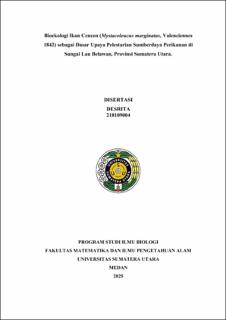Bioekologi Ikan Cencen (Mystacoleucus marginatus, Valenciennes 1842) sebagai Dasar Upaya Pelestarian Sumberdaya Perikanan di Sungai Lau Belawan, Provinsi Sumatera Utara
Bioecology of Yellow Finned Barb Fish (Mystacoleucus marginatus, Valenciennes 1842) as a Basis for the Effort to Conserve Fisheries Resources in Lau Belawan River, North Sumatra Province

Date
2025Author
Desrita, Desrita
Advisor(s)
Barus, Ternala
Efizon, Deni
Ilyas, Syafruddin
Metadata
Show full item recordAbstract
Lau Belawan River has the potential for yellow-finned barb fish (Mystacoleucus marginatus, Valenciennes 1842). Ecologically, yellow-finned barb fish is a fish resources that must be preserved because it has the potential to be developed. The study aimed to assess growth, feeding habits, reproductive biology, and environmental parameters. The research was conducted 6 months, from October 2023 to March 2024. The research location was in Lau Belawan river, North Sumatra province. The research locations were located in Namorih village (Station 1), Kampung Tengah village, Pancur Batu Subdistrict (Station 2), and Baru Ladang Bambu village, Medan Tuntungan Subdistrict, Deli Serdang Regency (Station 3). Fish sampling used a backpack electrofishing unit with 24 volts (2 batteries). The results explained that the total fish caught during the study was 516 yellow-finned barb fish (Mystacoleucus marginatus) collected from 3 stations. Each station is 146 individual collected from station 1, 148 individual at station 2, and 222 individual at station 3. For food habits, the results show that the relative intestinal length ratio and the composition of the main food of yellow-finned barb fish are classified as omnivorous fish tend to be herbivorous. The growth pattern of male and female yellow-finned barb fish is negatively allometric, the capture and total mortality rate of male yellow-finned barb fish is faster than female fish. The highest sex ratio occurred in October and station 1. The Gonado mature index (GMI) of the male yellow-finned barb fish was highest in January, females in March, and by station at station 2 for male yellow-finned barb fish and station 3 for female yellow-finned barb fish. Fecundity ranged from 561 to 4,792 oosit and the dominating oocyte size was only one class interval, meaning that yellow-finned barb fish were classified as total spawners when spawning. Environmental conditions in the Lau Belawan river still support the life of yellow-finned barb fish and plankton in terms of temperature, depth, brightness, current speed, pH, dissolved oxygen, nitrate, alkalinity, total dissolved solids (TDS), total suspended solid (TSS) and orthophosphate.
